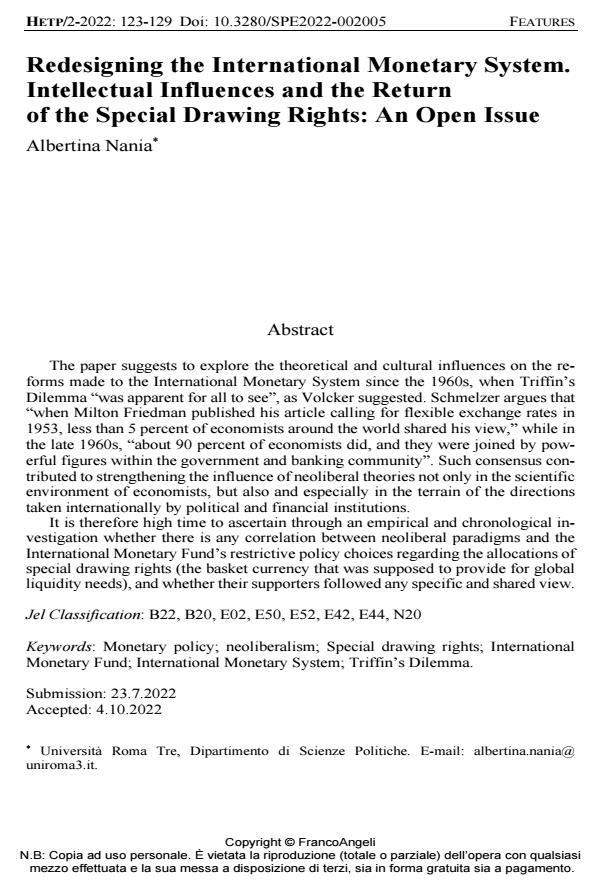Redesigning the International Monetary System. Intellectual Influences and the Return of the Special Drawing Rights: An Open Issue
Titolo Rivista HISTORY OF ECONOMIC THOUGHT AND POLICY
Autori/Curatori Albertina Nania
Anno di pubblicazione 2022 Fascicolo 2022/2
Lingua Inglese Numero pagine 7 P. 123-129 Dimensione file 35 KB
DOI 10.3280/SPE2022-002005
Il DOI è il codice a barre della proprietà intellettuale: per saperne di più
clicca qui
Qui sotto puoi vedere in anteprima la prima pagina di questo articolo.
Se questo articolo ti interessa, lo puoi acquistare (e scaricare in formato pdf) seguendo le facili indicazioni per acquistare il download credit. Acquista Download Credits per scaricare questo Articolo in formato PDF

FrancoAngeli è membro della Publishers International Linking Association, Inc (PILA)associazione indipendente e non profit per facilitare (attraverso i servizi tecnologici implementati da CrossRef.org) l’accesso degli studiosi ai contenuti digitali nelle pubblicazioni professionali e scientifiche
The paper suggests to explore the theoretical and cultural influences on the re-forms made to the International Monetary System since the 1960s, when Triffin’s Dilemma “was apparent for all to see”, as Volcker suggested. Schmelzer argues that “when Milton Friedman published his article calling for flexible exchange rates in 1953, less than 5 percent of economists around the world shared his view,” while in the late 1960s, “about 90 percent of economists did, and they were joined by powerful figures within the government and banking community”. Such con-sensus contributed to strengthening the influence of neoliberal theories not only in the scientific environment of economists, but also and especially in the terrain of the directions taken internationally by political and financial institutions. It is therefore high time to ascertain through an empirical and chronological investigation whether there is any correlation between neoliberal paradigms and the International Monetary Fund’s restrictive policy choices regarding the allocations of special drawing rights (the basket currency that was supposed to provide for global liquidity needs), and whether their supporters followed any specific and shared view.
Keywords:Monetary policy; neoliberalism; Special drawing rights; International Monetary Fund; International Monetary System; Triffin’s Dilemma
Jel codes:B22, B20, E02, E50, E52, E42, E44, N20
- Boughton J. M. (2004). The IMF and the Force of History: Ten Events and Ten Ideas That Have shaped the Institution. Washington (DC), International Monetary Fund.
- Chwieroth J.M. (2007). Testing and Measuring the Role of Ideas: The Case of Neoliberalism in the International Monetary Fund, International Studies Quarterly, 51(1): 5-30.
- Connell C. (2016). Reforming the World Monetary System: Fritz Machlup and the Bellagio Group. London and New York, Routledge
- Felder R. (2009). From Bretton Woods to Neoliberal Reforms: The International Financial Institutions and American Power. In Panitch L., Konings M. (eds). American Empire and the Political Economy of Global Finance. International Political Economy Series. London, Palgrave Macmillan.
- Flor E. (2018). I Diritti Speciali di Prelievo (Special Drawing Rights): da Bretton Woods alla moneta mondiale, (from Bretton Woods to a world currency), Banca Impresa Società, Rivista quadrimestrale, pp. 293-332.
- Hirsch F. (1973). An SDR Standard: Impetus, Elements, and Impediments, Princeton University, International Finance Section.
- International Monetary Fund (2020). Articles of agreement of the International Monetary Fund. Washington (DC), International Monetary Fund.
- Jelen I. and Stanic M. (2018). Il leviatano globale. Dalla Carta di Bretton Woods allo sviluppo dell’economia del debito. Trento, Edizioni del Faro.
- Maes I. (2021). Robert Triffin: A life. Oxford: Oxford University Press.
- Major A. (2012). Neoliberalism and the new international financial architecture, Review of International Political Economy, 19(4): 536-561.
- Mirowski P. and Plehwe D. (eds) (2009). The Road from Mont Pelerin. The Making of the Neoliberal Thought Collective. Cambridge (MA), Harvard University Press
- Montani G. (1989). Robert Triffin e il problema economico del XX secolo, Report presented at the Robert Triffin Jubilee: Evolution of the International and Regional Monetary Systems, (Bruxelles, 8-9 December 1988).
- Ocampo J. A. (2017). Resetting the International Monetary (Non) System. Oxford, Oxford University Press.
- Ostry J. D., Loungani P., and Furceri D. (2016). Neoliberalism: Oversold?, Finance & Development, 53(2): 38-41
- Padoa-Schioppa T. (2017). The Ghost of Bancor. Bologna, il Mulino
- Plehwe D., Slobodian Q., and Mirowski P. (eds.). Nine Lives of Neoliberalism, London and New York, Verso.
- Schmelzer M (2020). What Comes After Bretton Woods? Neoliberals Debate and Fight for a Future Monetary Order, in Plehwe D., Slobodian Q., and Mirowski P. (eds.). Nine Lives of Neoliberalism, London and New York, Verso.
- Triffin R. (1960). Gold and the Dollar Crisis: The Future of Convertibility, New Haven, Yale University Press.
- Viterbo A. (2022). The Reallocation of Special Drawing Rights to the Benefit of the African Continent: a Proposal for Euro Area Countries, CSF Research Paper, February, -- https://www.csfederalismo.it/it/pubblicazioni/research-paper/the-reallocation-of-special-drawing-rights-to-the-benefit-of-the-african-continent-a-proposal-for-euro-area-countries.
Albertina Nania, Redesigning the International Monetary System. Intellectual Influences and the Return of the Special Drawing Rights: An Open Issue in "HISTORY OF ECONOMIC THOUGHT AND POLICY" 2/2022, pp 123-129, DOI: 10.3280/SPE2022-002005